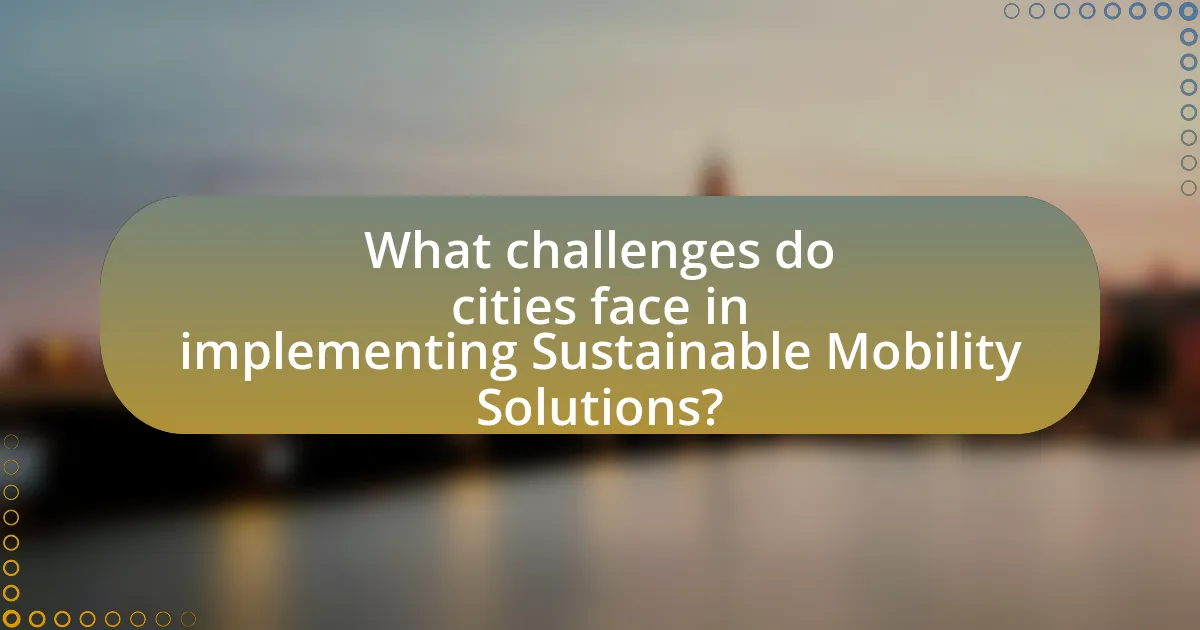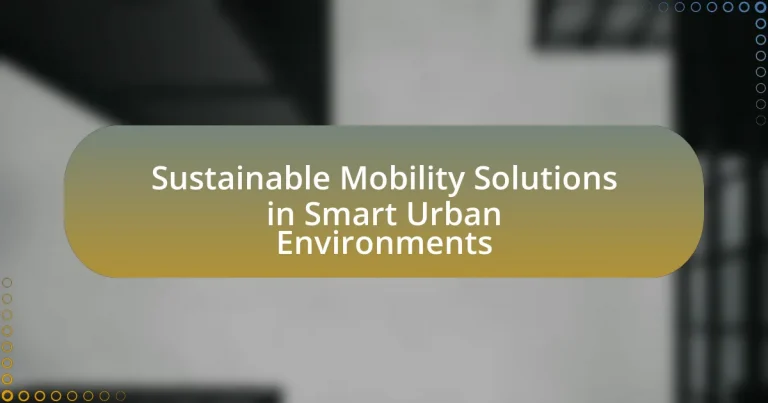Sustainable mobility solutions in smart urban environments refer to transportation systems that aim to reduce environmental impact while improving urban living conditions. These solutions encompass electric public transit, bike-sharing programs, pedestrian-friendly infrastructure, and data-driven mobility platforms. The article explores how these solutions contribute to urban development by enhancing accessibility, reducing traffic congestion, and promoting social equity. It also discusses the integration of sustainable mobility with existing infrastructure, the environmental benefits, and the challenges cities face in implementing these initiatives. Key characteristics, innovations in public transport, and the role of active transportation options are examined, along with strategies for overcoming resistance to change and best practices for stakeholder engagement.

What are Sustainable Mobility Solutions in Smart Urban Environments?
Sustainable mobility solutions in smart urban environments are transportation systems designed to minimize environmental impact while enhancing urban living. These solutions include electric public transit, bike-sharing programs, pedestrian-friendly infrastructure, and integrated mobility platforms that utilize data analytics for efficient routing. For instance, cities like Amsterdam and Copenhagen have successfully implemented extensive cycling networks, reducing carbon emissions and traffic congestion. Research indicates that cities adopting such sustainable practices can decrease greenhouse gas emissions by up to 30%, showcasing the effectiveness of these solutions in promoting eco-friendly urban mobility.
How do Sustainable Mobility Solutions contribute to urban development?
Sustainable mobility solutions contribute to urban development by enhancing accessibility, reducing traffic congestion, and minimizing environmental impact. These solutions, such as public transportation systems, cycling infrastructure, and pedestrian-friendly designs, promote efficient movement within cities. For instance, cities that invest in integrated public transit systems, like the Bus Rapid Transit in Bogotá, Colombia, have seen a significant increase in public transport usage, leading to reduced car dependency and lower greenhouse gas emissions. Additionally, studies indicate that improved mobility options can lead to economic growth by increasing access to jobs and services, thereby fostering vibrant urban communities.
What are the key characteristics of Sustainable Mobility Solutions?
Sustainable Mobility Solutions are characterized by their focus on reducing environmental impact, enhancing accessibility, and promoting social equity. These solutions prioritize the use of renewable energy sources, such as electric vehicles and public transportation systems, which significantly lower greenhouse gas emissions. Additionally, they incorporate smart technologies to optimize traffic flow and reduce congestion, thereby improving air quality. Evidence from various studies indicates that cities implementing sustainable mobility strategies experience increased public transport usage and reduced reliance on personal vehicles, leading to a more efficient urban transport ecosystem.
How do these solutions integrate with existing urban infrastructure?
Sustainable mobility solutions integrate with existing urban infrastructure by utilizing existing transportation networks, enhancing public transit systems, and incorporating smart technologies. For instance, electric vehicle charging stations can be installed at existing parking facilities, while bike-sharing programs can leverage current bike lanes and paths. Additionally, data-driven platforms can optimize traffic flow by synchronizing traffic signals with real-time data from public transport, thereby improving efficiency. These integrations are supported by studies showing that cities implementing smart mobility solutions experience reduced congestion and improved air quality, as evidenced by the Smart Cities Initiative, which highlights successful case studies from cities like Barcelona and Amsterdam.
Why are Sustainable Mobility Solutions important for cities?
Sustainable mobility solutions are important for cities because they reduce traffic congestion, lower greenhouse gas emissions, and improve public health. By promoting alternatives such as public transportation, cycling, and walking, cities can enhance accessibility while minimizing environmental impact. For instance, a study by the International Transport Forum found that shifting to sustainable transport modes can reduce urban transport emissions by up to 70% by 2050. Additionally, cities that invest in sustainable mobility often experience increased economic activity, as improved transportation networks facilitate better access to jobs and services.
What environmental benefits do these solutions provide?
Sustainable mobility solutions in smart urban environments provide significant environmental benefits, primarily by reducing greenhouse gas emissions and improving air quality. For instance, the implementation of electric public transportation systems can lower carbon dioxide emissions by up to 45% compared to traditional diesel buses, as reported by the International Council on Clean Transportation. Additionally, promoting cycling and walking through dedicated infrastructure decreases reliance on fossil fuel-powered vehicles, leading to a reduction in urban traffic congestion and associated pollutants. These solutions also enhance urban green spaces, which contribute to biodiversity and help mitigate urban heat effects, further supporting environmental sustainability.
How do they enhance the quality of life for urban residents?
Sustainable mobility solutions enhance the quality of life for urban residents by providing efficient, eco-friendly transportation options that reduce congestion and pollution. These solutions, such as electric public transit, bike-sharing programs, and pedestrian-friendly infrastructure, promote healthier lifestyles and improve accessibility. For instance, cities implementing bike-sharing systems have reported a 20% increase in cycling, leading to reduced traffic and improved air quality. Additionally, smart mobility technologies, like real-time transit tracking, increase convenience and reliability, making it easier for residents to navigate urban environments.

What types of Sustainable Mobility Solutions exist?
Sustainable mobility solutions include public transportation systems, cycling infrastructure, electric vehicles, car-sharing services, and pedestrian-friendly urban designs. Public transportation systems, such as buses and trains, reduce individual car usage and lower emissions. Cycling infrastructure promotes bike use, which is a zero-emission mode of transport. Electric vehicles contribute to sustainability by reducing reliance on fossil fuels and lowering greenhouse gas emissions. Car-sharing services optimize vehicle use and decrease the number of cars on the road. Lastly, pedestrian-friendly urban designs encourage walking, which is the most sustainable form of mobility. These solutions collectively aim to create efficient, eco-friendly transportation networks in urban environments.
How do public transportation systems fit into Sustainable Mobility Solutions?
Public transportation systems are integral to Sustainable Mobility Solutions as they reduce individual car usage, thereby lowering greenhouse gas emissions and traffic congestion. By providing efficient, reliable, and accessible transport options, public transit encourages a shift from private vehicles to shared modes of transport. For instance, studies show that cities with robust public transportation networks can reduce per capita carbon emissions by up to 45% compared to those reliant on personal vehicles. Additionally, public transportation systems promote social equity by offering affordable mobility options to diverse populations, enhancing overall urban sustainability.
What innovations are being implemented in public transport?
Innovations in public transport include the integration of electric and hybrid vehicles, real-time tracking systems, and contactless payment solutions. Electric and hybrid vehicles reduce emissions and improve air quality, aligning with sustainability goals. Real-time tracking systems enhance user experience by providing accurate arrival times and route information, which increases ridership. Contactless payment solutions streamline fare collection, making public transport more accessible and efficient. These innovations collectively contribute to the development of sustainable mobility solutions in smart urban environments.
How do these innovations improve efficiency and accessibility?
Innovations in sustainable mobility solutions enhance efficiency and accessibility by integrating advanced technologies such as electric vehicles, smart traffic management systems, and multimodal transport options. These technologies reduce travel time and optimize routes, leading to decreased congestion and lower emissions. For instance, smart traffic management systems can analyze real-time data to adjust traffic signals, improving flow and reducing delays by up to 30%. Additionally, electric vehicles and shared mobility services increase accessibility for underserved populations, providing affordable and reliable transportation options. Studies show that cities implementing these solutions experience a 20% increase in public transport usage, demonstrating their effectiveness in making urban mobility more efficient and accessible.
What role do active transportation options play?
Active transportation options play a crucial role in promoting sustainable mobility solutions within smart urban environments. These options, which include walking, cycling, and other non-motorized forms of transport, significantly reduce greenhouse gas emissions and traffic congestion. For instance, a study by the Institute for Transportation and Development Policy found that increasing cycling and walking can lead to a 30% reduction in urban transport emissions. Additionally, active transportation enhances public health by encouraging physical activity, which can decrease healthcare costs associated with sedentary lifestyles. Thus, integrating active transportation into urban planning is essential for creating environmentally friendly and livable cities.
How do cycling and walking initiatives promote sustainability?
Cycling and walking initiatives promote sustainability by reducing greenhouse gas emissions and minimizing reliance on fossil fuels. These initiatives encourage active transportation, which leads to lower carbon footprints compared to motorized vehicles. For instance, a study by the European Commission found that increasing cycling and walking can reduce urban transport emissions by up to 30%. Additionally, these modes of transport contribute to improved air quality and reduced traffic congestion, further enhancing urban sustainability. By fostering a culture of non-motorized transport, cities can create healthier environments and promote sustainable urban development.
What infrastructure is necessary to support active transportation?
To support active transportation, infrastructure such as dedicated bike lanes, pedestrian pathways, and secure bike parking is essential. Dedicated bike lanes provide a safe space for cyclists, reducing the risk of accidents with motor vehicles; cities with extensive bike lane networks, like Copenhagen, report higher cycling rates and lower injury rates. Pedestrian pathways enhance walkability, encouraging more people to walk, which is linked to improved public health outcomes. Secure bike parking facilities increase the likelihood of cycling by addressing concerns about bike theft, as evidenced by studies showing that cities with ample bike parking see increased cycling participation.

What challenges do cities face in implementing Sustainable Mobility Solutions?
Cities face significant challenges in implementing Sustainable Mobility Solutions, primarily due to funding constraints, infrastructure limitations, and public resistance. Funding is often inadequate, as cities struggle to allocate financial resources for new projects while maintaining existing services. Infrastructure limitations arise from outdated transportation systems that require extensive upgrades to accommodate sustainable options like electric buses or bike lanes. Public resistance can stem from a lack of awareness or perceived inconvenience associated with changing mobility habits. For instance, a study by the International Transport Forum highlights that cities with limited budgets often prioritize immediate needs over long-term sustainable initiatives, making it difficult to invest in comprehensive mobility solutions.
How do funding and investment impact these solutions?
Funding and investment significantly enhance sustainable mobility solutions in smart urban environments by providing the necessary financial resources for development and implementation. These financial inputs enable the creation of infrastructure, such as electric vehicle charging stations and bike-sharing systems, which are essential for promoting sustainable transportation options. For instance, a report by the International Energy Agency indicates that investments in electric mobility infrastructure can lead to a 30% increase in electric vehicle adoption rates. Furthermore, funding supports research and innovation, allowing for the development of advanced technologies like smart traffic management systems that optimize traffic flow and reduce emissions. Overall, adequate funding and investment are crucial for scaling up sustainable mobility initiatives and achieving urban sustainability goals.
What are the common sources of funding for sustainable projects?
Common sources of funding for sustainable projects include government grants, private investments, and crowdfunding. Government grants often come from local, state, or federal programs aimed at promoting sustainability, such as the U.S. Department of Energy’s funding initiatives for clean energy projects. Private investments are typically made by venture capital firms or impact investors who seek financial returns alongside social or environmental benefits. Crowdfunding platforms allow individuals and organizations to raise small amounts of money from a large number of people, facilitating community involvement in sustainable initiatives. These funding sources are crucial for the development and implementation of sustainable mobility solutions in smart urban environments.
How can cities attract private investment for mobility solutions?
Cities can attract private investment for mobility solutions by creating a favorable regulatory environment and demonstrating the potential for profitability. By implementing policies that incentivize innovation, such as tax breaks or streamlined permitting processes, cities can lower barriers for private companies. Additionally, showcasing successful pilot projects or partnerships can illustrate the viability of mobility solutions, encouraging further investment. For instance, cities like Los Angeles have attracted significant funding for electric vehicle infrastructure by collaborating with private firms and providing clear data on projected usage and revenue. This approach not only enhances investor confidence but also aligns with sustainable urban development goals.
What social and political barriers exist?
Social and political barriers to sustainable mobility solutions in smart urban environments include resistance to change from established transportation systems and lack of political will to implement innovative policies. Established transportation systems often have significant lobbying power, which can hinder the adoption of new technologies and practices. Additionally, political leaders may prioritize short-term economic gains over long-term sustainability goals, leading to insufficient funding and support for sustainable initiatives. For instance, a study by the International Transport Forum highlights that cities with strong political commitment to sustainability see a 30% higher implementation rate of green mobility projects compared to those without such commitment.
How do public perceptions influence the adoption of these solutions?
Public perceptions significantly influence the adoption of sustainable mobility solutions in smart urban environments by shaping the willingness of individuals and communities to embrace these innovations. Positive perceptions, driven by awareness of environmental benefits and improved quality of life, can lead to higher acceptance and usage rates of solutions such as electric vehicles, bike-sharing programs, and public transit enhancements. For instance, a study by the International Transport Forum found that cities with strong public support for sustainability initiatives saw a 30% increase in the adoption of electric vehicles compared to those with less favorable views. Conversely, negative perceptions, often stemming from concerns about cost, reliability, or safety, can hinder the implementation and success of these solutions, as evidenced by surveys indicating that 60% of potential users cite safety concerns as a barrier to using shared mobility services. Thus, public perceptions play a crucial role in determining the effectiveness and reach of sustainable mobility initiatives.
What strategies can be employed to overcome resistance to change?
To overcome resistance to change in the context of sustainable mobility solutions in smart urban environments, effective strategies include engaging stakeholders through transparent communication, providing education and training, and demonstrating the benefits of change. Engaging stakeholders fosters a sense of ownership and reduces fear, as evidenced by studies showing that participatory approaches lead to higher acceptance rates of new initiatives. Education and training equip individuals with the necessary skills and knowledge, which has been shown to alleviate anxiety associated with change. Additionally, showcasing successful case studies of sustainable mobility implementations can illustrate tangible benefits, such as reduced traffic congestion and improved air quality, thereby reinforcing the value of the proposed changes.
What are the best practices for implementing Sustainable Mobility Solutions?
The best practices for implementing Sustainable Mobility Solutions include integrating multimodal transport options, promoting active transportation, and utilizing smart technology for efficient traffic management. Integrating multimodal transport options, such as buses, trains, and bike-sharing systems, enhances accessibility and reduces reliance on single-occupancy vehicles. Promoting active transportation, like walking and cycling, encourages healthier lifestyles and decreases carbon emissions. Utilizing smart technology, such as real-time data analytics and traffic management systems, optimizes traffic flow and reduces congestion, leading to lower emissions. These practices are supported by studies indicating that cities implementing multimodal transport systems have seen a significant reduction in traffic-related emissions and improved public health outcomes.
How can cities effectively engage stakeholders in the planning process?
Cities can effectively engage stakeholders in the planning process by implementing inclusive participatory frameworks that facilitate collaboration and communication. These frameworks can include public forums, workshops, and digital platforms that allow stakeholders, such as residents, businesses, and community organizations, to voice their opinions and contribute to decision-making. Research indicates that cities employing participatory planning methods, like the City of Barcelona’s “Superblocks” initiative, have seen increased community involvement and satisfaction, demonstrating the effectiveness of stakeholder engagement in urban planning.
What metrics should be used to evaluate the success of these solutions?
To evaluate the success of sustainable mobility solutions in smart urban environments, key metrics include reduction in greenhouse gas emissions, increased public transport usage, and improved air quality. These metrics provide quantifiable evidence of the effectiveness of mobility solutions. For instance, a study by the International Council on Clean Transportation found that cities implementing electric public transport saw a 30% reduction in emissions compared to traditional diesel systems. Additionally, metrics such as user satisfaction surveys and modal shift percentages can further assess the impact on community acceptance and behavior changes towards sustainable transport options.


